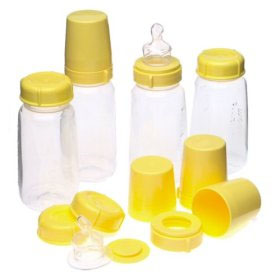After watching this week’s interview with Gerald Markowitz and David Rosner, you’ll probably be wondering what you can do to protect yourself and your family from toxic chemicals. Perhaps the most important thing you can do is become politically involved – join the fight against both chemicals in our environment and money in our political system. In today’s world, it’s virtually impossible to avoid dangerous chemicals, even in your own home, but here are a few simple steps you can take to limit your exposure to known toxins like lead, flame retardants and BPA.
Lead
If you think that lead poisoning is a problem of the past, or one that only affects the urban poor, think again. While it’s true that lead paint has been illegal since the 70s and leaded gasoline was phased out in the 80s, the highly toxic substance still lurks in old homes, parking lots, water pipes, and in products imported from countries that don’t have the same regulations. And while lead poisoning no longer the killer it once was, miniscule amounts of lead can cause neurological damage and behavioral problems in children. According to the CDC, there are currently half a million children with elevated levels of lead in their blood. Here’s what you can do to protect your family from lead poisoning:
1) Find out if there’s lead in your water. A good place to start is with your local government. website. At NYC.gov, for example, you can order a free testing kit. You can also try contacting your local water company, your landlord or a private lab. You may also want to install an NSF-certified water filter on your water tap. Though the EPA has mandated that water systems be tested for lead since 1991, your home’s own internal plumbing could still contain lead, particularly if you live in an older building.
2) Replace old windows. Though lead paint has been illegal since 1978 and has largely been removed from old buildings, in some cases, it was seen as too costly to replace the windows. To have your windows replaced (or to do any sort of renovation on a building that may still contain lead paint), contact an EPA-certified renovator who has been trained to follow lead safety practices. In some cases, your local government may cover the costs.
3) Throw out colorfully-painted toys that were made outside the U.S. or Europe. They may look innocent, but toys, crayons, ceramic and jewelry, particularly those manufactured in China or Mexico, may contain lead, and as any parent knows, children are likely to put these things in their mouths.
4) Dust or vacuum regularly. Even without any obvious source of lead in your home, there may still be lead in the air, particularly if you live in an industrial area or if a neighbor has been renovating an old home. Dust particles containing lead are especially dangerous to babies who crawl around on the floor. It’s also important to keep toys and hands clean.
5) Test the soil. Urban and suburban yards can still contain contaminants from the days when lead paint and gasoline were widespread. Before planting a garden or even letting your kids run around in the yard, make sure the soil is lead-free. Your local public health department may offer free testing; you can also contact a private or university-run lab.
Flame Retardants
 The hazards of flame retardants have been known for some time — brominated tris was banned from children’s pajamas back in 1977. And yet, similar chemicals can still be found in everything from couch cushions to television sets. Studies have linked one group of flame retardants, polybrominated diphenyl ethers, or PBDEs, to lower IQs, behavioral problems, early puberty and fertility issues. And the fire-safety benefits of these chemicals are debatable. Here’s what you can to keep toxic flame retardants out of your home:
The hazards of flame retardants have been known for some time — brominated tris was banned from children’s pajamas back in 1977. And yet, similar chemicals can still be found in everything from couch cushions to television sets. Studies have linked one group of flame retardants, polybrominated diphenyl ethers, or PBDEs, to lower IQs, behavioral problems, early puberty and fertility issues. And the fire-safety benefits of these chemicals are debatable. Here’s what you can to keep toxic flame retardants out of your home:
1) Check the labels on your furniture. The California Furniture Flammability Standard essentially requires that cushioned furniture, children’s car seats, diaper-changing tables and other products containing polyurethane foam are dipped in toxic chemicals. (Don’t breathe a sigh of relief just because you live in one of the other 49 states — because of California’s size, most mass-produced furniture is designed to meet California’s standard). Check the tags for the familiar notice: This article meets the flammability requirements of California Bureau of Home Furnishings Technical Bulletin 117. (The tag is not required though, so just because you don’t see it doesn’t mean it’s safe.) Fortunately, California has proposed changing the rule; until that happens, you can look for products made with wool, cotton or polyester filling instead of polyurethane foam. And if you can’t afford all new eco-friendly furniture, be sure to dust, vacuum and wash your hands regularly — most of the toxins enter the body by swallowing contaminated dust.
2) Check the labels on electronics, too. Flame retardants have long been used in electronic equipment like computers and television sets. Thankfully, that’s slowly changing. As of 2008, the following companies had committed to phasing out all brominated flame retardants: Acer, Apple, Eizo Nanao, LG Electronics, Lenovo, Matsushita, Microsoft, Nokia, Phillips, Samsung, Sharp, Sony-Ericsson, and Toshiba. To find flame retardant-free versions of everything from refrigerators to nose-hair clippers, check this list created by ChemSec, an environmental non-profit based in Sweden.
3) Beware of fleece pajamas. Though one flame retardant, brominated tris, was banned from children’s pajamas, some sleepwear is still treated with another flame retardant called PROBAN which has been linked to genetic abnormalities and cancer. Check the label — children’s pajamas that DO NOT contain flame retardants must have a tag that reads: “For child’s safety, garment should fit snugly” (the snug fit limits the flow of oxygen in order to prevent fire from spreading, an approved alternative to chemical flame retardants). Cotton and polyester products rarely contain flame retardants, but look out for those cozy fleece footed pajamas — they usually do.
BPA
 Bisphenol A, or BPA, has been linked to cancer, asthma, obesity and reproductive issues. And yet, until recently, the chemical was found in, among other things, baby bottles. The FDA finally banned the use of BPA in baby bottles and children’s sippy cups in 2012 — three years after major manufacturers had voluntarily stopped using it. But BPA is still found in other hard plastic containers, the lining of metal cans and the paper that receipts are printed on. It’s difficult to completely avoid BPA — 90 percent of Americans have traces of the chemical in their urine. But here are some things you can do to limit your exposure:
Bisphenol A, or BPA, has been linked to cancer, asthma, obesity and reproductive issues. And yet, until recently, the chemical was found in, among other things, baby bottles. The FDA finally banned the use of BPA in baby bottles and children’s sippy cups in 2012 — three years after major manufacturers had voluntarily stopped using it. But BPA is still found in other hard plastic containers, the lining of metal cans and the paper that receipts are printed on. It’s difficult to completely avoid BPA — 90 percent of Americans have traces of the chemical in their urine. But here are some things you can do to limit your exposure:
1) When purchasing plastic products — particularly those that come into contact with your food, such as food storage containers, plastic plates and cups, look for those that are clearly marked BPA free. Thanks to vocal consumers, many companies are now manufacturing BPA-free products and marketing them as such.
2) Avoid food containers marked with recycling codes 3 or 7, which may be made with BPA. If your food does come in a container marked 3 or 7, don’t microwave it in that container – chemicals are more likely to leak into your food at high temperatures.
3) Limit your consumption of canned foods, or look for cans marked BPA free — they are rare, but do exist. Eden Organic cans have been BPA free since 1999.
4) BPA is often used in the thermal paper that receipts are printed on. Since it’s impossible to know whether or the receipt you’re being handed has contains BPA, don’t take receipts that you don’t need. If you operate a business that uses receipts, switch to a BPA-free paper manufacturer, such as Appleton Paper, which went BPA-free in 2006.


